West Coast’s Young Leaders Visit Farm-to-Fork Capital
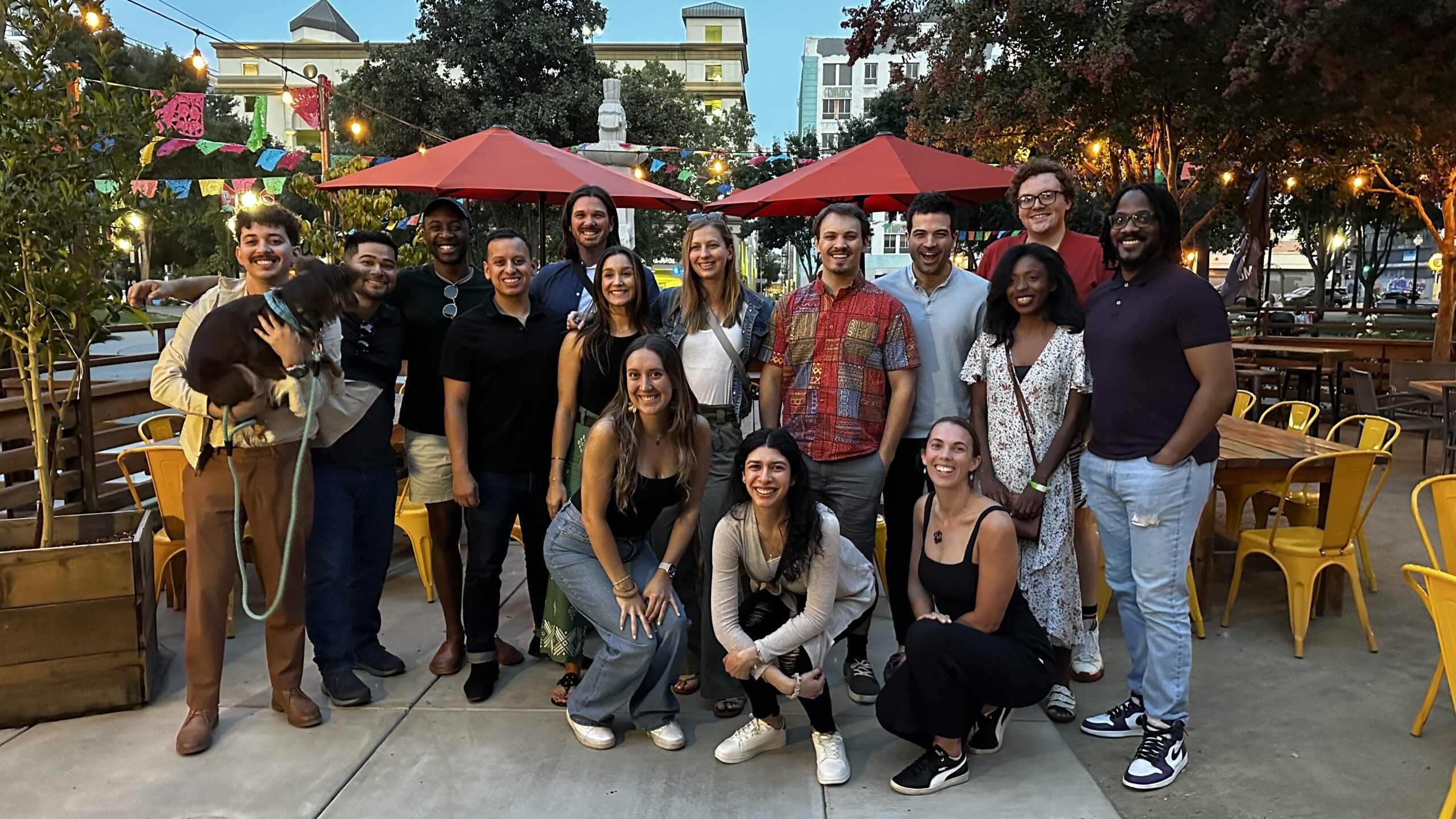
Flashback to Project Leader Adrian Rehn’s blog from five years ago: “Our team looks forward to harnessing this momentum, expanding our community partnerships, and doing another mind-blowing thing in the not-too-distant future.”
Five years and one pandemic later, the Sacramento Hub of the Global Shapers – the youth leadership network of the World Economic Forum – has done it again! From September 22-24th, Sacramento Hub members hosted young leaders from San Francisco, Oakland, and Phoenix for a weekend full of connection, impactful dialogue, and challenging preconceived notions while showcasing the best of Sacramento’s arts and culture.
Valley Vision has been the fiscal agent for the Global Shapers – Sacramento Hub for several years. Through this formal partnership, the Sacramento Hub has access to a high-performing and trusted local nonprofit that manages its finances and records, keeping things running smoothly. For Valley Vision, the Global Shapers bring a unique connection to the global community not found in other young leaders groups, which further boosts VV’s toolset in advancing the livability of the Sacramento region.
Sacramento: More than Just a Capital
The 2023 Global Shapers West Coast Retreat, as it was billed, was a revelation for many in that it shattered preconceived notions about Sacramento. While often seen only as just the capital of California, Sacramento proved to be much more. As Amy Vatcha, a San Francisco Global Shaper, put it:
“From the innovations in indoor farming & microgreens, to the art walks/art exhibitions/murals, to the salsa and bachata night at Dance on the Edge on the waterfront, I experienced the depth and variety of what Sacramento has to offer.”
Members of the Sacramento Hub were encouraged to shape the retreat based on their own connections to the city and their interests, including but not limited to:
- Guided tours of Sacramento’s many murals and art installations
- A private tour of the California State Capitol building
- A meet-and-greet with local urban agriculture leaders and entrepreneurs
- Salsa dancing lessons on the Old Sacramento Waterfront
- Leadership development sessions and cross-Hub skill-building
Connecting Young Leaders Beyond Boundaries
Beyond its role in showcasing Sacramento’s vibrant culture, the retreat emphasized the importance of connecting young leaders outside of their existing networks to think globally, and act locally. Adam Shipley, the Phoenix Hub’s curator, noted:
“Understanding perspectives across industries, demographics, and geographies helps us all create and maximize our community impact. [The] Sacramento Hub took the first proactive step in launching new dialogues.”
With this emphasis, the retreat underscored the significance of breaking down barriers and fostering a more holistic understanding of the challenges and opportunities facing our communities. It demonstrated that when young leaders unite with open hearts and minds, they can collectively address pressing issues and create a more interconnected, prosperous world.
Authentic Fellowship and Community Connection
Throughout the retreat, Shapers experienced the commitment to authenticity that has made the Sacramento Hub a long-lasting group. As Raphaël Tshitoko, San Francisco’s Vice Curator, put it:
“I can see how they’ve carefully nurtured their connection within their Hub, leading to genuine enjoyment of each other’s company, to how they’ve nurtured their connection to their community, intentionally creating spaces of togetherness but also being connectors by associating with and supporting leadership in their own neighborhood.”
Sacramento Hub members emphasized the importance of deep camaraderie rooted in shared values and experiences, where members actively nurture relationships within their group while also engaging passionately with their local community. This authentic bond goes beyond networking, fostering lasting connections and a sense of trust, unity, and shared purpose among its members.
Ultimately, the West Coast Retreat was a resounding success, leaving participants feeling optimistic and energized for their future involvement with their communities. The Sacramento Hub could not have pulled off this production without the help of our fantastic sponsors: Balanced Body, UC Davis Graduate School of Management, Councilmember Karina Talamantes, Revolution Winery, and our longstanding fiscal agent, Valley Vision.
To keep up with Valley Vision’s work to advance livability in the Sacramento region, subscribe to our Vantage Point email newsletter!
Students Call for More Mentorships, Access and Support

Valley Vision joined youth, employers, educators, and service providers for the Sacramento Youth Summit on August 9th. The event, led by Sacramento Mayor Darrell Steinberg’s Office and co-sponsored by Sacramento State, aimed to unite young individuals aged 16 to 24, employers, educators, and service providers. The goal was to learn about and address the challenges the city’s youth face as they transition from education to employment.
The morning session included opening remarks by Mayor Steinberg, President Wood, and others emphasizing the importance of cooperation and dedication to driving change for equitable access to programs and mentorships for the city’s youth. Following, the day’s activities were divided into two tracks: one for employers, educators, and practitioners, with a second for youth.
Valley Vision’s 21st Century Workforce Impact area team attended the event and hosted a breakout session for youth participants. Liz Kilkenny, Project Associate, noted the emphasis from youth panelists on the need for more mentorships. “Youth expressed a desire for more opportunities to be with people who share their demographics and history, who have already walked the path they are trying to walk and have become successful. They want mentors who can show them the way, not just point them in a direction.” Project Associate DiAngelo Andrews noted young people are voicing the same concerns throughout the region in multiple initiatives he has participated in. “Young people are consistently expressing a need to address transportation and safety concerns, and the need for clear access to resources with support on how to use them to be successful in employment and their overall lives. The same problems have existed generationally; the time to solve them is now.” Project Leader Hilary Tellesen shares, “Young people are hungry for someone to guide them to and through resources and processes, including applying for scholarships, job applications, interview preparation, and researching careers.”
During the interactive breakout session, Valley Vision hosted entitled “What Employers Are Looking For,” youth learned about the top in-demand skills represented in job posting data and what those skills mean. Our team shared the importance of developing adaptable workplace skills, including communication, teamwork, and overall professionalism to meet the needs of employers in a constantly changing marketplace. Youth had an opportunity to create an introductory elevator pitch and practice with their peers. Additional information was provided on how skills are changing with the increase in technology adoption and guidance on how to be prepared for the future of work. Youth attendees were meaningfully engaged, asked good questions, and were actively searching for practices to improve their opportunities to transition to a successful career.
In summary, the Sacramento Youth Summit allowed young community members to express their opinions and share their perspectives to inform Sacramento’s educators, employers, service providers, and decision makers. Youth attendees gained practical knowledge and had ample networking time with many panelists and industry representatives. The summit facilitated significant conversations and encouraged cooperative efforts between industry experts, workforce stakeholders, and program developers to address future labor and skills shortages by engaging the city’s youth. Valley Vision was pleased to be involved and do our part to foster a highly skilled and adaptable workforce that meets regional employers’ evolving needs.
Reinventing Our Communities (ROC): A Coast-to-Coast Convening

On July 21st, 2023, Valley Vision had the unique opportunity to visit Cleveland, Ohio for an in-person gathering of cohorts from the Federal Reserve Bank of Philadelphia’s Reinventing Our Communities (ROC) Program. The ROC Cohort Program is an in-depth racial equity training program for cross-sector community groups across the U.S. to apply local solutions to increase opportunity and strengthen local economies. Valley Vision served as the facilitator for the Yolo County cohort, which consisted of the following organizations:
- Yolo County Health & Human Services Agency/YoloWorks!
- Yolo County Public Health
- Yolo Workforce Innovation Board
- Winters Chamber of Commerce
- Woodland Community College
- Federal Reserve Bank of San Francisco
Joined by several other cohorts across the United States, the ROC program provided specialized racial equity training sessions hosted by Race Forward, as well as workforce development workshops from Federal Reserve personnel and industry experts. This program aimed for participants to gain skills and create a tailored racial equity plan that addresses local challenges.
For 2022, the ROC program asked participants to focus on equitable workforce recovery. As Yolo County is known for its abundance of farmland, the Yolo County Cohort chose farmworkers as the demographic to center their year-long project. The consulting firm, Race Forward, helped us shape our goals through an exercise called the Root Cause Analysis.
In this exercise, we were instructed to start with our goal–in this case, a racially-equitable workforce recovery plan for farmworkers–and delve into the obstacles in its path. Some of the obstacles our cohort identified were: lack of adequate funding sources, especially for undocumented individuals; the rising cost of living, including food; unsafe working conditions; and a lack of affordable, sustainable housing.
This exercise helped us create the following framework:
- Our cohort knew that because farms are busier during certain times of the year, many seasonal employees are hired to work during these specific bursts and are often unemployed during slower, winter months. As a result, the winter months pose a significant challenge to farmworkers, whose quality of life depends on the harvest season.
- A lack of stable income makes it difficult to afford viable housing and sufficient food for themselves and their families year-round.
- This issue is even more problematic for undocumented farmworkers who are ineligible for federal aid, such as CalFresh and unemployment benefits.
During this process, the Financial Assistance Plan (FAF) for Farmworkers program was created. The FAF program provided unemployed farmworkers timely and accessible one-time checks of one thousand dollars to be used in the procurement of essential needs during the winter off-season. When it was launched in the spring of 2023 by Yolo County Health and Human Services, the application was highly successful, filling up the available slots in less than a day, which shows the dire need for support for farmworkers. This pilot was a valuable opportunity to test the demand and process, both of which matched our expectations. Our cohort’s hope is to continue this program so that it is more widely accessible to even more farmworkers who need assistance with affording housing and food.
This project is only one example of what came to fruition during the ROC program. In Cleveland, Valley Vision presented these findings and the FAF program to cohorts from the 2020, 2021, and 2022 program years. In addition to learning about the projects from other regions, attendees received additional in-person racial equity and communications training to take back to their communities.
We are incredibly grateful for this opportunity, the Federal Reserve Bank of Philadelphia, and the organizations who partnered with us to make this possible!
To read more about the 2022 Reinventing Our Communities program, click here. More information about the 2024 application process can be found here.
Building Bridges: Advancing Gender Diversity in the Trades

The trades in the Greater Sacramento region, like many other areas, has long grappled with a significant gender disparity, with men predominantly occupying the majority of roles. However, evolving workforce demographics and the increasing demand for talent have spotlighted the untapped potential and valuable contributions women can bring to these occupations. Fostering a diverse talent pool becomes imperative to ensure industry demands for talent are met. This article explores the challenges facing women, potential solutions, and calls the region to greater action to address this inequity.
Women continue to be significantly underrepresented in the trades, posing a substantial obstacle to achieving gender diversity and hindering progress. Statistics reveal that only 3.5% of individuals enrolled in apprenticeships, a crucial entry point for the industry, identify as women. Nationally, the representation of women in the trades remains low. Gender diversity brings numerous benefits to the trades, enhancing innovation, problem-solving capabilities, improving productivity and teamwork, and reflecting the needs and preferences of diverse stakeholders. Research conducted by The Peterson Institute for International Economics and EY suggests that organizations with diverse female leaders experience a significant increase in their net margin. This research underscores the economic advantages of cultivating a more inclusive workforce.
Women in the trades face various challenges and biases, with the lack of affordable and accessible childcare consistently cited as a significant barrier. As primary caregivers, addressing the need for childcare is crucial to ensure women’s accessibility to trades occupations. Recent developments, such as California’s allocation of $25 million in Equal Representation in Construction Apprenticeship Grants (ERiCA), demonstrate a commitment to creating career opportunities for women, non-binary individuals, and underserved populations in the building and construction sectors. Funds granted can be used for supportive services for childcare, and outreach for state registered construction pre-apprenticeship and apprenticeship programs.
Additionally, individuals identifying as women and girls need increased exposure to trades occupations to envision themselves in these roles. Events such as a Women in Skilled Trades Day sponsored by the Sacramento Municipal Utility District (SMUD) play a crucial role in fostering interest and creating connections toward these careers. This event provided on-site childcare to increase participation by women wanting to attend. The event also offered an opportunity to network and learn from experienced professionals. Social factors, including gender role expectations, contribute to many women being less prepared than their male counterparts for positions in the trades resulting in reduced exposure to math and technical skills, familiarity with tools and equipment, and knowledge about the breadth and pathways for these careers.
Fostering gender inclusion in the trades is essential to meet the talent needs of the Greater Sacramento region. Increasing exposure to these lucrative careers by creating career exposure events tailored to the unique needs of women can expand access to more talent and build stronger and more equitable talent pipelines. Efforts to foster a more diverse talent pipeline require challenging stereotypes, confronting biases, improving access to apprenticeships and career pathways, and providing necessary support, such as child care assistance. These efforts will contribute to a more diverse and vibrant workforce in the region, leading to stronger long-term growth, innovation, and economic success for our future.
Building Our Inclusive and Prosperous Economy
Our region has a tremendous opportunity in front of us with the Community Economic Resilience Fund (CERF) to build an inclusive and prosperous economy for our region. Valley Vision, as the CERF Regional Convener, is leading a $5M planning process over the next year to grow a regional coalition that will identify, build, and advance equity-centered economic development opportunities in our eight-county region including Colusa, El Dorado, Nevada, Placer, Sacramento, Yolo, and Yuba counties.

In late June, we kicked off our summer-of-learning together for the coalition featuring Professor Manuel Pastor as our guest speaker for our first coalition-wide meeting. Professor Pastor encouraged us to follow three main guiding principles:
- Stop talking about “the economy” and start talking about “our economy”: We have ownership over many aspects of our regional economy and this is expressed in how we invest in people, education, communities, and more. Our economic conditions are built by us and we have the ability to build a human-centered economy.
- Treat people fairly and our economy will prosper – economies that reduce income, racial, and geographic divide disparities are able to sustain more economic growth and prosperity over time. Creating equitable opportunities for diverse people is not just morally right, it captures more talent and creates more prosperity and a better quality of life for all.
- To effectively disrupt the existing systems of power, we must expand the circle of belonging and invite those in who have been excluded. Doing this will surface tension and potential conflict – we can’t be afraid to face challenging conversations and social dynamics and need to build effective skills and systems within our coalition that will enable us to navigate these challenges.
The lessons that he imparted to us, as well as his walk-through of our region’s demographic and economic data that reflect opportunity and challenge areas for us, sets the stage for our regional coalition to understand and advance principles and approaches to inclusive economic development in the scope of the CERF process. You can find the recording and Professor Pastor’s slides here.
This webinar was the first in a monthly series that will bring in people and examples of inclusive and sustainable economy-building that can help inform and support our coalition as we get deeper into planning and working together as a coalition. Our next learning session is July 27th from 3-5 pm; stay tuned!
Affordable housing, traffic congestion, and pace of regional growth top respondents’ list of most pressing concerns
SACRAMENTO, CA: May 24, 2023 — Valley Vision, in partnership with the Sacramento Area Council of Governments (SACOG), released new research findings today from a public opinion survey that captured attitudes on the region’s built environment. The poll provides a snapshot of the public’s priorities and concerns with respect to the built environment, including transportation, housing, telework, and public health.
Respondents overwhelmingly say that they believe the region’s top priorities are increasing affordable housing and reducing traffic congestion. 49 percent of respondents cite their own neighborhood as unaffordable, and 79 percent of respondents think that first-time homeowners will have a more difficult time buying a home in five years. Renters are more likely to view the increasing cost of housing as their biggest concern (64 percent).
“Poll respondents are experiencing hardships associated with rising housing costs and have concerns about what that means for the future,” explained Valley Vision CEO Evan Schmidt. “The findings also revealed that 54% of respondents think we should slow down on housing development despite housing affordability being the biggest concern about growth in the region.”
Construction of attached housing – apartments, condominiums, townhomes, duplexes, triplexes, etc. – has seen a decreasing share of overall housing construction for at least the last two decades. 31 percent of the region’s existing homes are attached, but that share is shrinking as over 80 percent of homes built since 2001 have been single-family homes. The need for greater housing variety becomes more apparent when the respondent demographics are examined closely. 53 percent of renters say that more attached housing should be prioritized.
“We understand that our region is fast growing, we know traffic congestion is a major concern, and that we have to address the housing affordability crisis,” said SACOG’s CEO James Corless. “But the question is not if we grow, it’s how we shape that growth. These poll results allow us to make sure we’re listening to the needs and desires of residents while still thinking about how life will be different in 5, 10 and 25 years into the future.”
93 percent of respondents indicated that they use a personal vehicle most of the time for their commute, however people are commuting less with less predictable schedules compared to before the pandemic. When it comes to other modes of transportation, 53 percent of renters see public transit as a convenient and accessible alternative to cars and 43 percent of respondents noted that walking and bike paths have gotten better in the last five years. At the same time, traffic congestion remains a significant concern for most people.
“Traffic congestion concerns require solutions that encourage public transit, increased focus on walking and biking, and creating smart road systems that minimize congestion on freeways when possible,” Corless added.
Notably, respondents feel strongly about more open space for recreation. 64 percent of respondents
said that they would like to see more parks and trails brought to their communities. “We have considerable assets in our region,” said Schmidt. “Local parks, rivers, trails, and open space amenities are time and time again identified as the most important amenities that we have in the region and it’s critically important that we preserve these assets and to enhance their use and quality throughout the region.”
A strong majority of our youngest respondents (18-34 years old) are optimistic and supportive of California’s goal to transition to all-electric vehicle sales by 2035 (72 percent). According to respondents, affordability and lack of adequate charging infrastructure is what is likely to get in the way.
“Understanding local perspectives like these is critical to making informed decisions and can help regional leadership proactively address expressed public priorities, values, and needs,” said Corless. “SACOG is using these findings to inform the region’s long-range plan, the 2025 Blueprint.” The 2025 Blueprint is the only regional plan that guides investments in transportation and land-use for the region 25 years into the future. Projects included connecting people from where they live to where they work and live, developing mixed use housing choices, and protecting our region’s natural and working landscapes.
The Built Environment poll was fielded from October through December 2022 by the Institute of Social Research at Sac State. The poll is the latest in a series of studies that Valley Vision has conducted since 2017 to inform policymakers, help target investments, and support data-driven action throughout the region.
“We believe that continuing to develop our understanding of residents’ perspectives about their neighborhoods and lived experiences provides the basis needed to drive positive policy, investment, and regional change,” said Schmidt. “Valley Vision will continue to be an ongoing resource of this type of opinion research on matters important to our future.”
The Built Environment survey respondent group consisted of 1,744 residents from El Dorado, Placer, Sacramento, Yuba, Sutter, and Yolo counties. The panel is weighted to demographically represent the region and each survey achieves a statistically valid margin of error of not more than +/- 3 percent. Learn more about the polling program by visiting https://www.valleyvision.org/projects/regional-attitudes-opinion-surveys/.
For 29 years, Valley Vision has brought people together from across a political and geographic spectrum to design solutions to big regional problems. Valley Vision is a trusted interpreter, commentator, forecaster and work partner for community inspired solutions and widely recognized as a leading research, civic planning and action agency that takes an independent and systemic approach to economic, social, and environmental issues.
Valley Vision to Support New USDA Regional Food Business Center
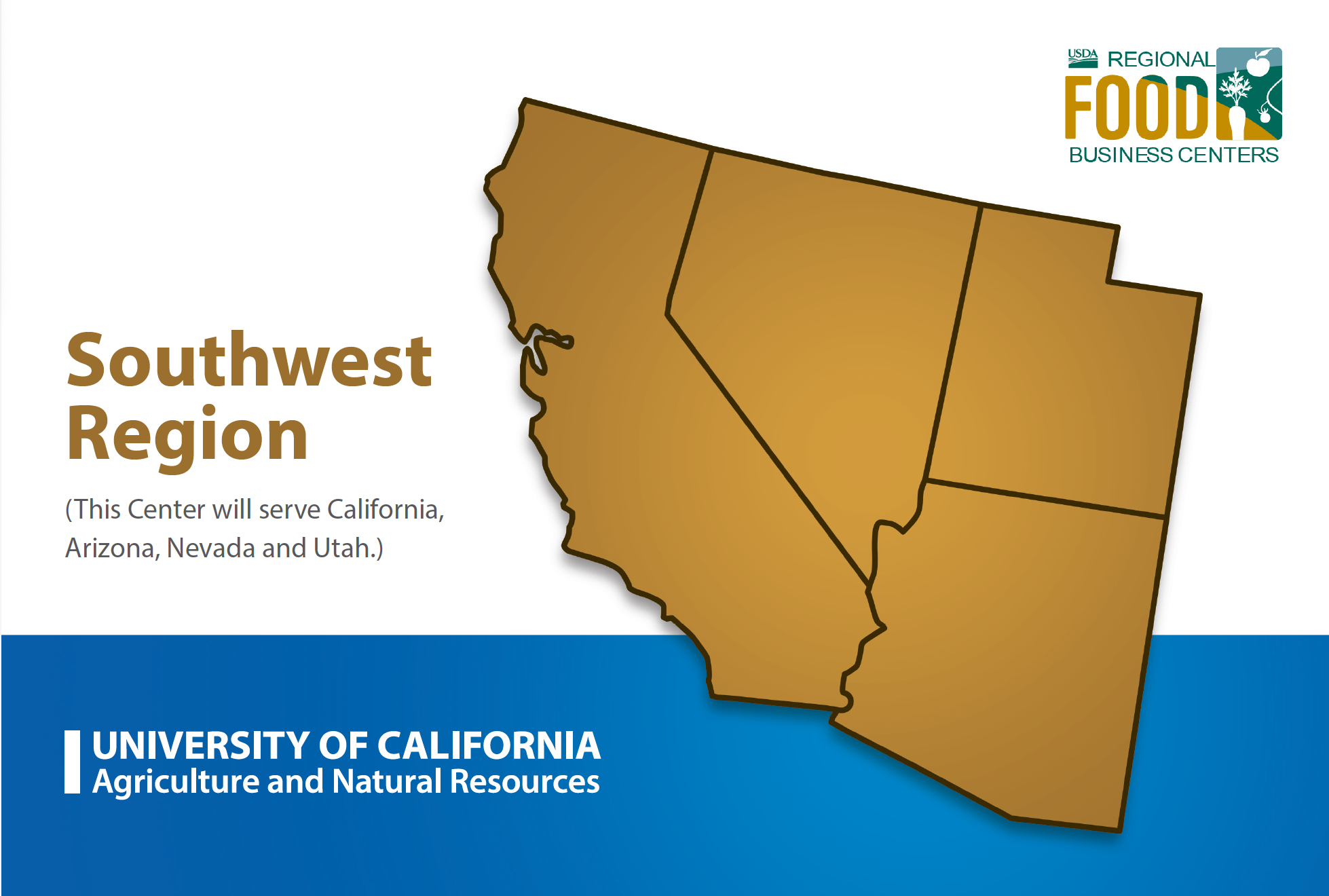
As announced earlier this month, Valley Vision is proud to be part of the new USDA Southwest Regional Food Business Center—one of 12 new Centers across the country that will support a more resilient, diverse, and competitive food system by providing assistance to strengthen local and regional supply chains. The University of California Agriculture and Natural Resources (UC ANR) is the lead applicant for the Center, and Valley Vision will serve as the Hub Director.
“The Regional Food Business Centers, along with investments through the Resilient Food Systems Infrastructure Program, will create new and expanded local market opportunities which will improve farm income, create good paying jobs and build greater resilience in our overall food system,” said Agriculture Secretary Tom Vilsack.
The Southwest Center covers California, Nevada, Arizona, and Utah. Tribal nations and Colonias Communities along the Southern border are also included. Through its network of partner organizations, the Southwest Center will conduct place-based technical assistance and capacity-building across this four-state region. The goal of the Center is to build a ‘coalition of coalitions’ that delivers multi-sector coordination efforts and business development programs to strengthen local producers’ economic viability, improve the supply chain’s resilience, and center equity in regional food systems.
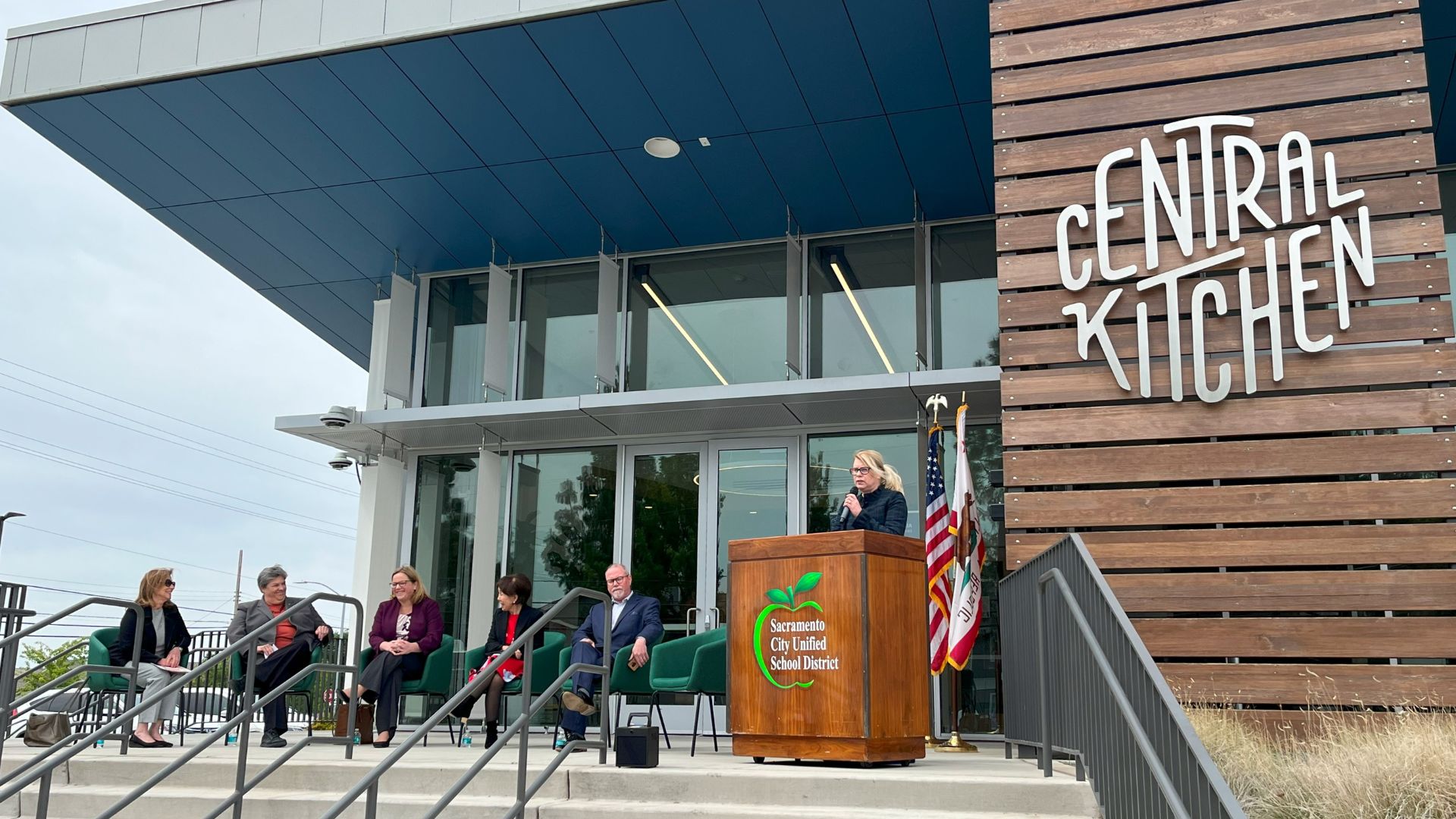
The Southwest Center was formally announced on May 3rd at Sacramento City Unified School District Central Kitchen. Valley Vision helped coordinate the event, which featured Jenny Lester Moffitt, Under Secretary of USDA Agricultural Marketing Service; Congresswoman Doris Matsui, (CA-7); Glenda Humiston, Vice President of UC Agriculture and Natural Resources; Sacramento Supervisor Patrick Kennedy and SACOG Board Chair; Diana Flores and Kelsey Nederveld from Sacramento City Unified Nutrition Services; and Trish Kelly, Managing Director, Valley Vision.
With local asparagus, potatoes, and grass-fed braised beef served out of the Central Kitchen’s Food Truck—showcasing how Fresh Food to School across the District is sourced from local farmers and prepared at the Central Kitchen—the event highlighted the strength of the local food system, including our diverse partnerships and networks that span across the Sacramento region, exemplifying the goals of the new Center.
The event concluded with a tour of the Central Kitchen, encompassing 50,000 SQ of warehouse space and 50,000 SQ of the facility itself. This tour was an opportunity to demonstrate the food system infrastructure we are building in this region, as well as the types of projects the Southwest Center will support.
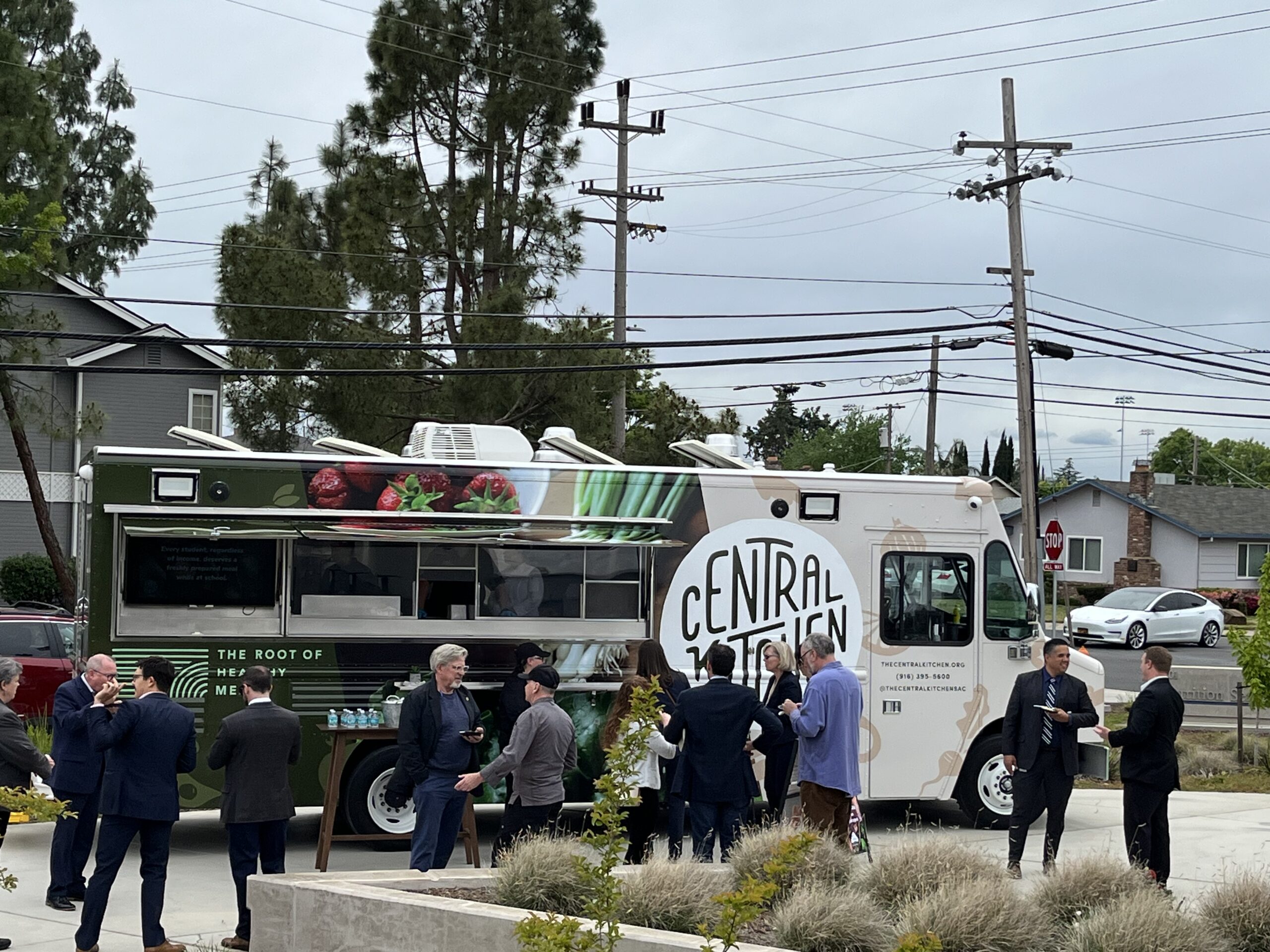
The Southwest Center and the Tour of the Central Kitchen would not be possible without the support of Secretary Moffitt, with whom we had the pleasure of meeting the week before during the 2023 Cap to Cap program; Congresswoman Matsui for being a champion for our region’s food system; Supervisor Kennedy, for his leadership that led to the development of the Central Kitchen; and Diana Flores and Kelsey Nederveld, who worked tirelessly to get the Central Kitchen operational. We are extremely grateful for the leadership of Glenda Humiston and her team in supporting diverse partners across the Southwest Region by anchoring the development and implementation of this project.
Trish Kelly will serve as the Director for the Center, supporting network coordination for outreach activities across the four states, development of community partnerships, and knowledge sharing. Grace Kaufman will support Valley Vision’s efforts, including managing stakeholder engagement, strategic planning, network coordination, outreach activities, and resource-sharing across the Southwest region.
The USDA grant will encompass five years and will contribute to Valley Vision’s capacity to serve as a backbone for the Sacramento region’s food and agriculture system. The project is anticipated to begin this summer.
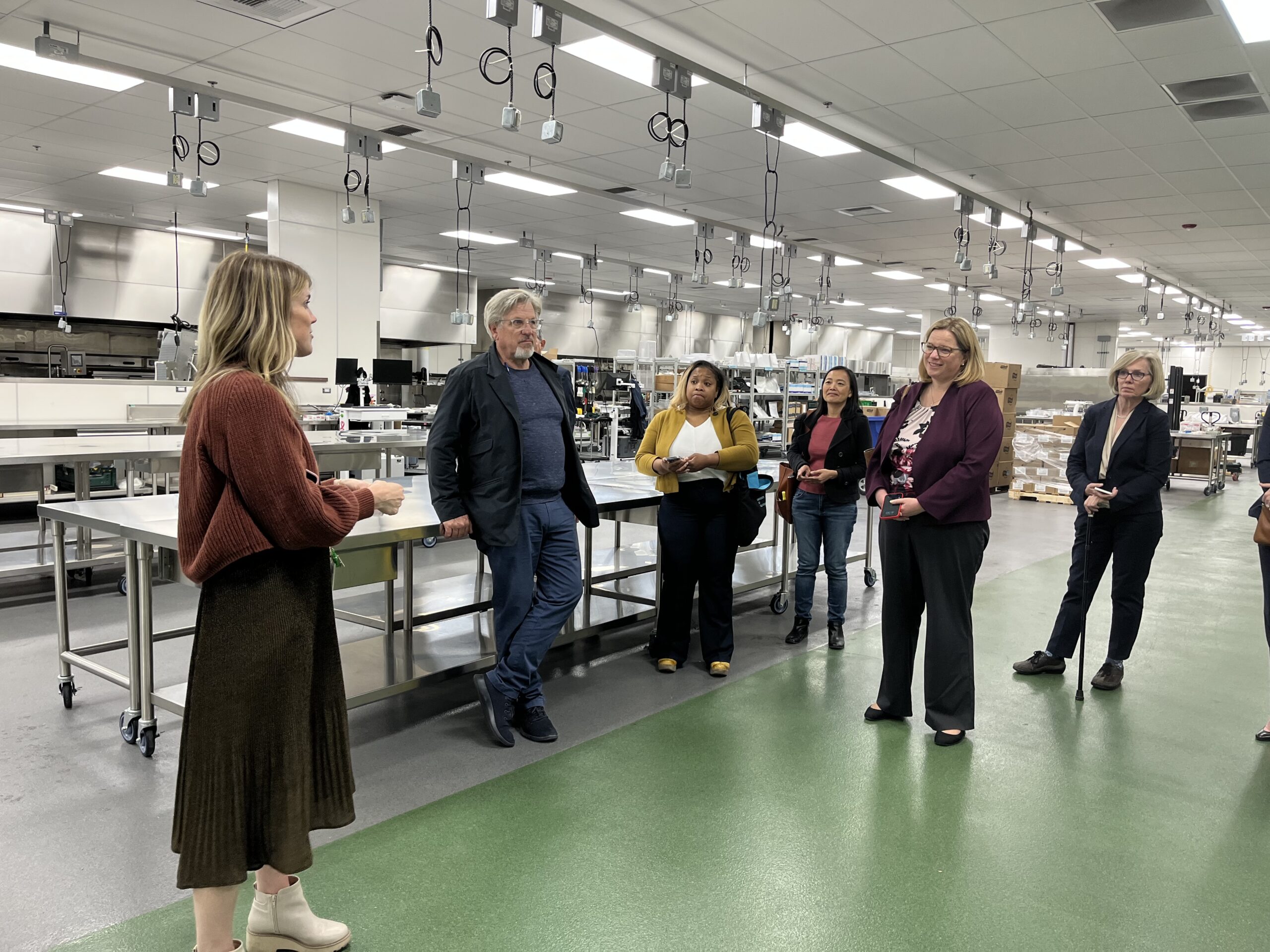
The Center’s network of Partners includes the California Department of Food and Agriculture (CDFA); California State University – Chico and Fresno; Occidental College; the Riverside Food System Alliance; the San Diego Food System Alliance; the University of California – Santa Cruz and Davis; Valley Vision; the Arizona Department of Agriculture; the Local First Arizona Foundation; the University of Arizona; the Nevada Department of Agriculture; the University of Nevada – Reno; the Utah Dept. of Agriculture; and Utah State University.
Center Collaborators include a wide network of organizations across the four states, including the Community Alliance with Family Farmers (CAFF); the Center for Good Food Purchasing; California FarmLink; Kitchen Table Advisors, Health Care Without Harm, and many others.
You can find more information about the program and the other Centers here: https://www.ams.usda.gov/services/local-regional/rfbcp.
To read more about the Sacramento Region’s food system projects and the work Valley Vision is supporting, go to WeAreFarmToFork.org.
If you’d like more information or to get involved with Valley Vision’s food and agriculture work, please contact us at FoodAndAg@ValleyVision.org.

A Federal Advocacy Agenda
Right now is a critical time to be engaged with the Federal government. There are once-in-a-generation resources available for the “big play” investments that our region needs to grow and thrive. Valley Vision has a long history of participating in our region’s annual Cap-to-Cap trip hosted by the Sacramento Metro Chamber.
This year we had leadership, or Co-Chair roles, on four teams (Air Quality, Economic Development, Food & Ag, and Workforce), and Trish Kelly, our Managing Director, served as Honorary Chair of the trip in recognition of her role in the region as a policy expert as well as her many years of Cap-to-Cap leadership. Our five Valley Vision staff who attended advanced our region’s sophisticated advocacy agendas; read about their experiences below.
Adrian Rehn
Each year, the Sacramento Metro Chamber puts together an excellent and well-regarded “Capitol-to-Capitol” Federal advocacy program – the biggest of any Chamber-led effort in the country. Attending the program is an enormous honor and privilege, with 407 participants this year, including 100+ freshmen and 100+ elected officials, and a whole lot of others with important leadership roles in our region. This year was no exception – the Chamber absolutely nailed the look and feel of the 2023 program.
The meat of the program is fast-paced advocacy meetings with our legislative delegation as well as committee and agency staff. The Cleaner Air Partnership, which Valley Vision staffs, leads one of twelve policy-focused “teams” dedicated to air quality. This year, our team elevated specific investments in Future Mobility projects like the ZEV Deployment Strategy and CA Mobility Center, and technical but extremely important policy fixes like letting air districts “write off” smoke from preventative prescribed fire instead of getting dinged by U.S. EPA. We are following up this week and next on these important “Asks” and look forward to continued engagement throughout the year as we continue to work toward cleaner air for all.

Grace Kaufman & Trish Kelly
Each year, Valley Vision’s participation in the Capitol to Capitol provides us an opportunity to advocate for the needs of the Sacramento Region on a national level. This year, the Food and Agriculture team was particularly impactful in highlighting the importance of the food system and the agricultural industry to the region’s economy and overall well-being. The team focused on the importance of supporting local food farms. ranches, food producers, nonprofits, food banks, restaurants, local governments, schools, hospitals, and businesses across the supply chain to ensure access to healthy, locally-sourced food for all. We advocated for improvements in the 2023 Farm Bill that would ensure access to critical programs that address food insecurity – a major challenge in our region – such as CalFresh. The discussions with our congressional delegation and agencies such as USDA and EDA provided the opportunity to highlight several of the region’s food and ag projects, focus on food as medicine, learn about new resources, and elevate our region as a place where all things food and ag are coming together through innovative and collaborative partnerships.
Over the course of five days, the program was an invaluable opportunity to engage with policymakers and advocate for programs that would benefit the region’s agricultural industry and ensure that everyone has access to healthy, nutritious, and local food. Meeting with congressional and administration leaders who are advancing the National Strategy on Hunger Nutrition and Health led to commitments to continue working together this coming year.
To read more about food and ag in the Sacramento region, check out our website at wearefarmtofork.org.
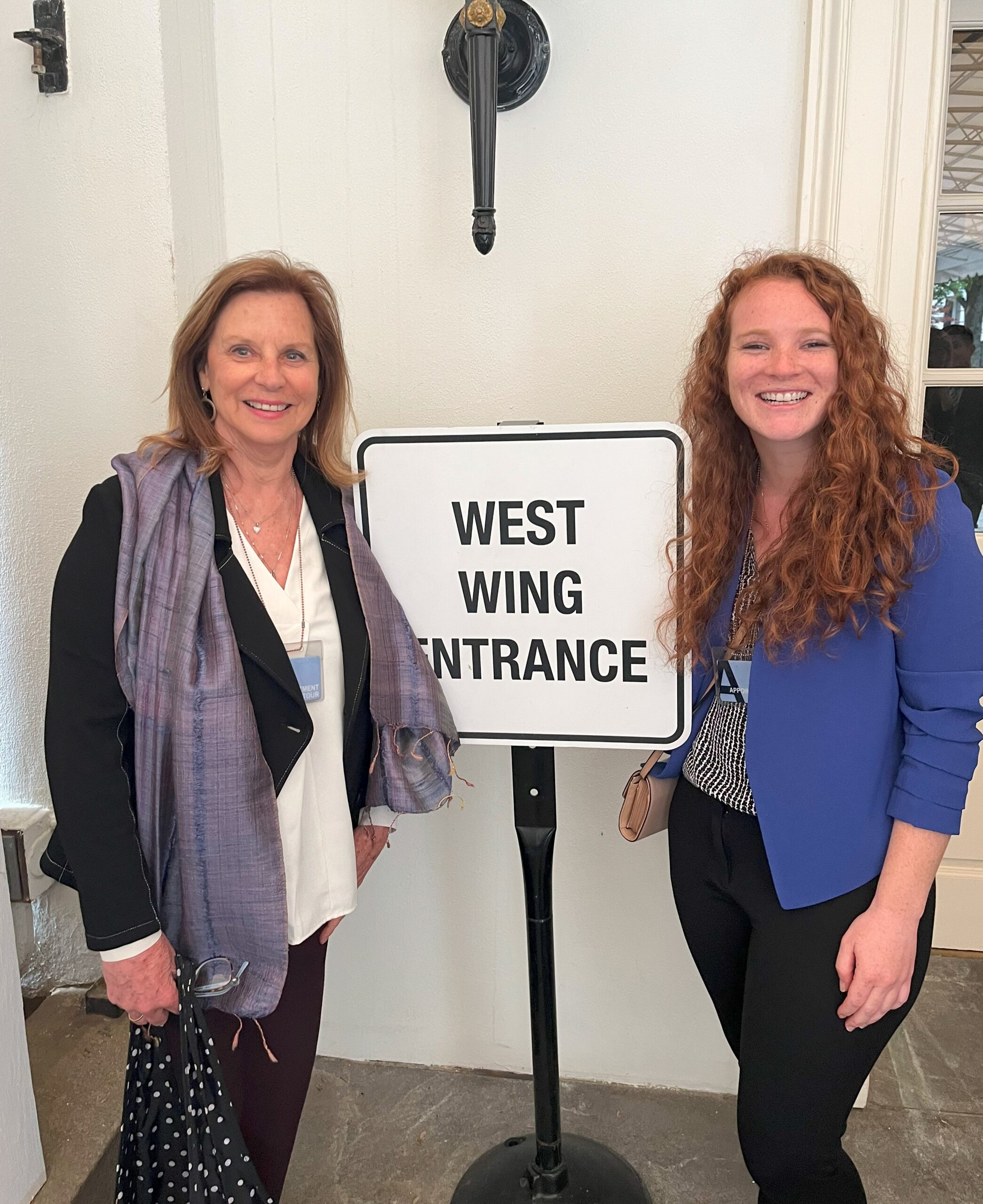
Trish and I also had the opportunity to tour the West Wing of the White House. It was my first time visiting Washington DC and seeing the historic building that has housed the world’s most powerful leaders was truly awe-inspiring.
During the tour, we were shown the various rooms and corridors of the West Wing, including the Oval Office, the Cabinet Room, and the Situation Room (and in case you’re wondering-yes, the vacuum lines are perfect in the Oval Office). The press room, a room that offers a glimpse into the inner workings of the media and the way news is reported from the White House, was a huge highlight of the tour for me.
Renee John
Participating in the Sacramento Metro Chamber’s Cap to Cap program provides a well-orchestrated vehicle for regional leaders to advocate in unison on important policy issues. In the area of workforce development, major federal legislation is currently in the reauthorization process. This includes the Workforce Innovation and Opportunity Act, which provides the most significant federal investment in workforce education and training programs. Additionally, the National Apprenticeship Act, which has not been reauthorized since 1937, is being shaped and expanded. Participating in meetings with congressional leaders and committees that design these and other legislation brings an opportunity to express what works well, and what is in need of adjustment from the folks doing the work on the ground.
I have found the folks in Washington to be very interested in our efforts in California, in the region, and particularly appreciate specific examples of how the components of legislation either benefit or constrain local efforts. This year also provided an opportunity to shine a light on collaborative efforts in workforce and education unique to California and the Greater Sacramento area.

Evan Schmidt
Cap-to-Cap not only enables our region to connect with federal representatives and agencies, but it also creates a concentrated space to connect with each other. Through team meetings, receptions, mixers, and plenty of informal gatherings our region goes to Washington to get things done in the Sacramento region. Key on my mind during the trip was inclusive economic development. Through the Economic Development team, we advocated for our key priorities from the Prosperity Strategy, timely investments in broadband infrastructure, support to build out our innovative ecosystem of entrepreneurs, and a continued emphasis on international trade that connects our businesses to the global marketplace.
With Valley Vision leading the regional Community Economic Resilience Fund effort, we are well-positioned to hone in on the ways that federal partners can help us leverage this state investment to amplify the impact. Our region is also exploring the ways that new legislation might help support regional economic goals. One example is the CHIPS and Science Act – a recent federal investment in high-tech manufacturing designed to strengthen manufacturing, supply chains, and national security. We found our federal partners to be responsive to our goals and we found many opportunities and alignments with them and among each other as we work to support thriving, equitable, and sustainable communities here at home.
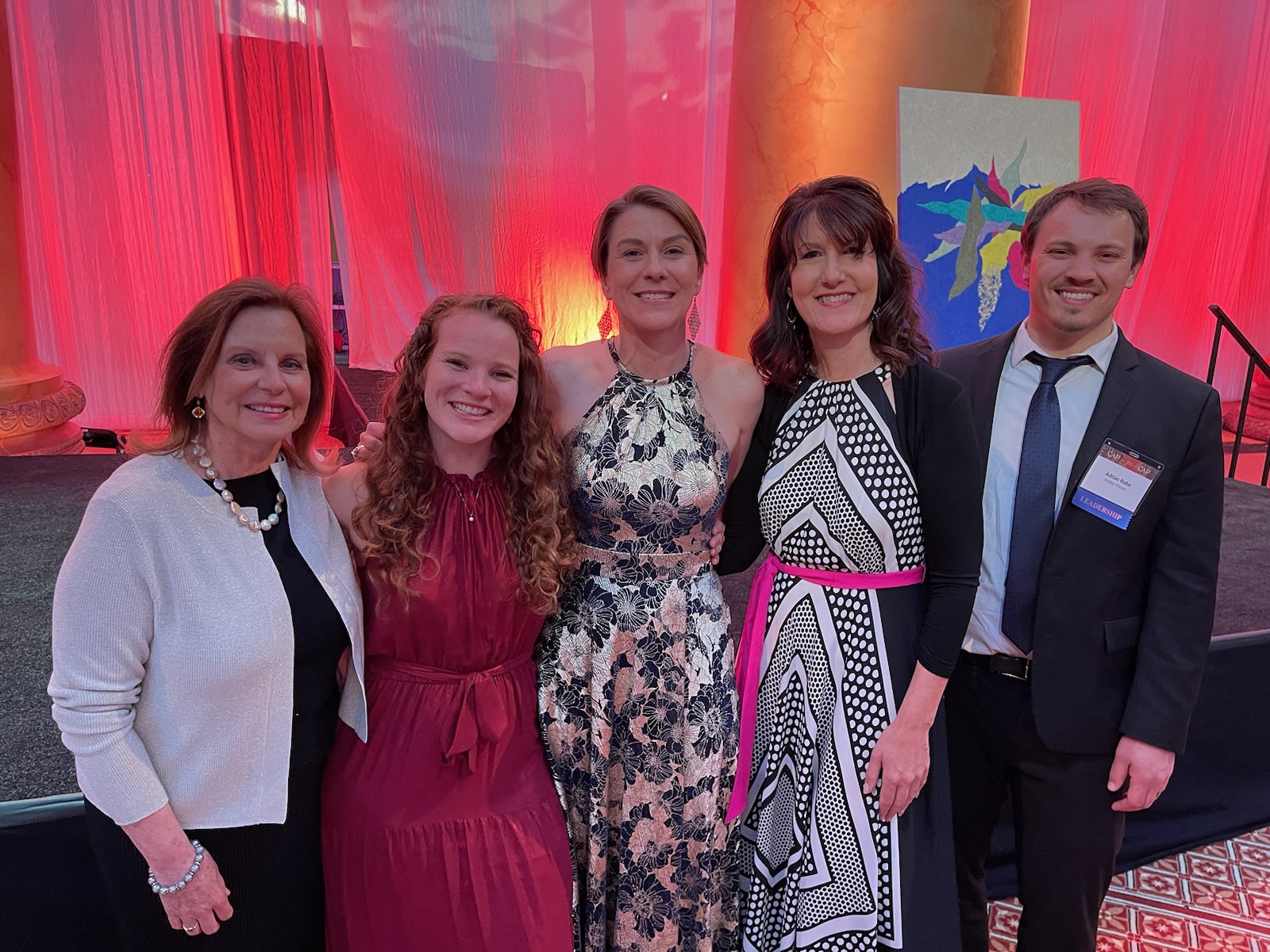
Lighting the Way: Breaking Down Barriers in Firefighting Careers

Becoming a firefighter is a dream for many, but in California, it can be a long and arduous journey. The average time it takes to land a firefighting job in the Golden State is between two to five years, but for Chief Felipe Rodriguez, that timeline stretched to seven years. As he put it, “I have wanted to be a firefighter since I was seven years old, and I went ahead and prepared myself and took another [firefighting] test and guess what? You don’t make it. Seven years later, I got the call.”
Unfortunately, Chief Rodriguez’s story is not an outlier. Many aspiring firefighters are facing similarly long timelines to achieve their dream job. With a shortage of firefighters throughout the state, the requirements for prospective firefighters have increased, and the training times have become longer. This bottleneck is preventing many people from pursuing their dreams of becoming a firefighter.
To explore this issue, Valley Vision, in collaboration with Los Rios Community College district, held a regional firefighting careers advisory in the Greater Sacramento Region on April 5th. Panelists, labor market experts, and community college representatives all shared their insights on the challenges facing prospective firefighters in the region. It’s clear that California needs to do more to ensure that future firefighters are able to pursue their passions without facing unnecessary barriers.
The event featured a keynote from Felipe Rodriguez, Chief of Cosumnes Fire Department, a statewide firefighting labor market report from Sara Phillips, Regional Director of the Far North Center of Excellence, and local firefighting career data from Ebony Benzing, Research Manager for the North/Far North Center of Excellence. The Fire Advisory had a regional industry panel that included:
- Christopher McCandless, US Forest Service, District Fuels Specialist
- Arianna Duran, CAL FIRE, Associate Governmental Program Analyst
- Julie Ride, Cosumnes Fire Department, Fire Captain
- Tim White, Sac Metro, Firefighter
- Lawrence Whang, Sacramento Fire Department, Fire Captain
At the beginning of the event, Phillips provided statewide labor market information on entry-level firefighting careers, demonstrating that local and municipal departments typically have the most stringent pre-employment training requirements, with the Los Angeles Fire Department requiring 560 hours of pre-employment training. Firefighters at the municipal/county level start out as reservists or volunteers until they have their Firefighter 1 and EMT/Paramedic Certifications, complete in-house firefighting training, and obtain state certification. High school degrees are required, but to be promoted to higher level positions, most individuals require an associate’s degree. Outside of local and municipal hiring, federal agencies and private contractors typically have lower pre-employment training requirements, but can have complicated hiring procedures at the federal level. Staffing patterns show that local agencies comprise 93% of firefighting employment in the state. At the local level, Benzing provided labor market information on firefighting and prevention jobs for the Greater Sacramento region. The findings showed a 7% projected change in job growth for the Greater Sacramento region, double that of the state of California. Within the last three years, there have been 618 unique online postings for firefighting jobs. While job growth is projected to outpace the state as a whole, both Benzing and Phillips stated that when qualitative interviews were conducted, key stakeholders explained that there is a shortage of firefighters in different departments.
The panel discussion emphasized the importance of hiring diverse candidates, a need for more paramedic firefighters, and removing bottlenecks to increase qualified candidates. Panelists agreed: the challenges to recruiting diverse candidates are cultural barriers and the cost of different qualifications. Captain Rider explained these hurdles by stating: “There are so many people that can walk into law enforcement agencies or public safety, but when they come to fire and see that there’s a process, it’s not like they can just join the fire department and they automatically get a job… we’d prefer that they have experience.” Panelists highlighted that reaching out through the region to different partnerships and community partners is an effective way to expand their reach, but more work needs to be done to remove barriers like cost to the firefighting careers process.
To create a more proactive firefighting career pipeline, firefighter Tim White highlighted successful methods of outreach for students, citing career technical education (CTE) programs as the most effective method that they and other local fire departments have found to inform young students about achieving a career in the firefighting industry. Most panelists had similar experiences with the success of CTE in high schools, with Captain Whang highlighting two high schools, Inderkum and Valley High, as being successful fire youth academies. Their current youth academies offer a 30-week academy of local Sacramento students, and at week 25 the academies have kept 31 out of the 31 students that started the program.
As our region works towards building a more inclusive and equitable firefighting workforce, increasing CTE programs, removing barriers to receiving certifications, and providing the necessary education for diverse applicants is vital to meet the diversity and talent needs of the industry.
To keep up with Valley Vision’s work to advance a future-ready workforce in the Sacramento region, subscribe to our 21st Century Workforce email newsletter!
Remembering Jane Hagedorn

On March 14, 2023, longtime Breathe CA Sacramento Region CEO Jane Hagedorn passed away. Jane led the formation of the Cleaner Air Partnership in 1986 and stewarded countless local clean air initiatives for more than three decades.
Jane Hagedorn’s passing leaves a hole in my professional development as Breathe California Sacramento Region’s Acting CEO. While I was able to glean tips from Jane, I certainly felt there was much more to learn from her. Jane hired me after completing her Nonprofit Management Class at UC Davis’ Graduate School of Management in 2003. I was impressed by her confidence yet ability to carefully listen and strategize. She then became a mentor to me as I watched her interact with policymakers, leaders and her staff. She knew how to bring people together, even when it appeared that there wasn’t common ground. The Cleaner Air Partnership is a perfect example of Jane’s vision to make progress in improving air quality by involving a variety of groups and individuals. I appreciated her ability to skillfully delegate tasks and lead by example. She saw our organization through significant structural changes and led the charge to independent and relevant programming in the region. Thank you, Jane, for your leadership and friendship.
Jennifer Finton, Acting CEO of Breathe California Sacramento Region
The Cleaner Air Partnership began in early 1986 when Jane Hagedorn, Executive Director of the American Lung Association of Sacramento-Emigrant Trails (ALASET) approached the President of the Sacramento Metropolitan Chamber of Commerce, Mike Seward, and the Air Pollution Control Officer of the Sacramento County Air Pollution Control District, Norm Covell, to jointly sponsor a public-private partnership to support air quality improvement in the region. The concept of an economic and environmental alliance was appealing to all of the parties.
One of the reasons I admired Jane was she was willing to listen and respond even if it went a bit against the grain. The best example is the fact that she agreed to put out the report card for air quality improvements to counter the annual Lung Association report on how our region still got an F rating for air quality. We had done so much to reduce the number and severity of exceedances but were still getting hammered by the annual report. She recognized that it was important to give a little credit to the partners that had work so hard to bring our numbers down. A little pat on the back to encourage folks to keep working together to achieve the ever lower standards.
Becky Wood, Fmr. CAP Chair, Teichert Aggregates (retired)
In her many years of civic involvement, Jane was a Leader for various organizations including being the 1st female ever appointed to the Sacramento County Planning Commission and was recognized by the Sacramento Bee as one of the Most Influential Women in Sacramento County. She was also the award recipient of the Sacramento Audubon Society and Environmental Council of Sacramento and a Fellow of the American Leadership Foundation. Her numerous board member positions included the Tahoe Regional Planning Authority; Arden Park Recreation District, California Planning and Conservation League; Sacramento Symphony; Friends of Light Rail; and Valley Vision.
I remember her as a tenacious advocate for the breathing public in the Sacramento Region. In particular it was through her and others’ leadership that we were able to keep strong local programs in California under the Breathe California structure when the American Lung Association national leadership wanted to go another direction. That wasn’t an easy time but turned out OK in the end.
Larry Greene, Fmr. Air Pollution Control Officer, Sac Metro Air District
For more about Jane, read her Obituary and the Cleaner Air Partnership history document on the Valley Vision website. Thank you for taking the time to remember Jane.
To keep up with Valley Vision’s work to advance livability in the Sacramento region, subscribe to our Vantage Point email newsletter.
Adrian Rehn is a Project Leader overseeing the Cleaner Air Partnership and Valley Vision’s Clean Economy portfolio.
Building a Skilled & Diverse Workforce in Manufacturing

On February 9th, Valley Vision hosted a hybrid Advanced Manufacturing Regional Advisory bringing stakeholders and industry partners together to discuss the current state of the sector, future trends and projections, and opportunities for growth. President and CEO of the California Manufacturers & Technology Association, Lance Hastings, opened the event with a compelling statement on the future of manufacturing, “How we leverage our resources, both human and natural, is really going to be the future of what manufacturing can do in California and we cannot rest on our laurels.” Hasting’s outlook on the future of manufacturing reflects the urgency of an industry that generates over 300 billion dollars of California’s GDP output, with the number expected to rise in the post-pandemic recovery and reshoring efforts to address supply chain disruptions.
At the hybrid event, the regional director of Greater Sacramento Centers of Excellence, Aaron Wilcher, shared data detailing specialized manufacturing industries in the Greater Sacramento area that have a higher percentage growth compared to the rest of California. The sectors with the highest employment shares in the Greater Sacramento region included rail stock, food & beverage manufacturing, beer, and construction components.
The Century Foundation provided information on diversity and inclusion efforts in Manufacturing and their collaboration with the Urban Manufacturing Alliance. These organizations are leading twelve Industry & Inclusion Cohorts in community colleges across the nation, including Sierra College in Rocklin, focused on building ecosystems and increasing racial equity in the sector.
The advisory also included a panel of industry employers including: Sara Lausmann – TSI SemiConductors, Derek Palos – Origin Materials, Kevin McGrew – Siemens, Fraser Marshall – DMG MORI USA, Inc., and Jeppe Johansen – TOMRA. The panelists discussed partnering with Diversity, Equity, and Inclusion firms and collaborating with community-based organizations in specific zip codes as ways to increase community member awareness of manufacturing careers and diversify their workforce. Panelists unanimously agreed on the need for more women in the industry and some noted the success of women in training programs, often surpassing their male counterparts in job offers and placement.
The most urgent needs identified by panel members were employment candidates with specific technical skills at the intersection of electrical, information technology and manufacturing. While in the past, many of these organizations were able to train individuals with little to no experience, this is shifting due to the advancement of technology. All employers were active in providing internships and emphasized the value of hands-on learning combined with classroom education to provide a more job-ready talent pool.
Panelists were enthusiastic about the resurgence of the industry while also acknowledging the substantial collaborative efforts needed to ensure talent demands are met, with the future of manufacturing set to have 2.1 million manufacturing jobs unfulfilled by 2030.
To read more about this manufacturing advisory, connect HERE. And, to keep up with Valley Vision’s projects to advance a future-ready workforce in the Sacramento region, subscribe to our 21st Century Workforce email newsletter!
Disengaged Workers: A Spotlight

Economic data experts are unnerved that despite low national unemployment rates and a remarkable increase in job openings, large numbers of the working population remain “disengaged”. A disengaged workforce is characterized as working-age community members that are unemployed and currently not looking for work. Understanding and addressing the reasons why this demographic population remains out of the workforce could direct community stakeholders to a future action plan.
Studies that focus on causes of the low labor force have recently been published that may inform our region’s employers, educators and community members invested in developing and enhancing workforce livability. An analysis of the labor shortage crisis in “The Demographic Drought: Bridging the Gap in our Labor Force,” defines the workforce issue as the decline in qualified talent in the labor market. The article reports on the total number of working age people and the labor force participation rate (working-age people that are currently working or actively looking for work). The report asserts that the working-age population will continue to increase, but at a historically low rate, which will not outpace the retiring generation. In short, with birth rates and immigration rates declining, the numbers of working age or “entry-level” workers are not projected to replace the retiring-age workforce, thus “…a growing number of companies [will be] depending on a shrinking number of workers” (Lightcast).
As reported in Bloomberg in January 2023 and in the Lightcast report, strategies to engage working-age populations include offering better benefits. In terms of offering improved benefits, these studies emphasize improved child care options or even cash subsidies because “child care expenses can undercut the economic benefits of returning to work, especially for lower-wage workers.” In October 2022, the Centers of Excellence in conjunction with Valley Vision published a report on the early childhood education workforce in the Sacramento region including recommendations to address the deepening workforce shortage. Local governments and businesses may need to work together to craft creative solutions for bringing workers back, including addressing the childcare gap.
Another strategy that yields fruit in both employee attraction and retention is ensuring career pathways within business and industries to provide workers both opportunities to advance and build additional skills. Workers won’t advance if they don’t have the skills to do the more complex work that will increasingly be in demand in the future of work. Employers have an important job, to inform programs that can prepare current and disengaged workers with the skills needed for the careers to come. Valley Vision works in this area, serving as the region’s intermediary, bringing together employers and industry leaders to inform education and workforce stakeholders on the current and changing demands of work.
To create a vibrant and prosperous economy, our region must have a talented workforce – educated, trained, and ready. Long gone are the days when it was enough to put up a help wanted sign to fill a vacancy. Collaborative efforts and solutions are the necessary components to bridging the gap between the disengaged labor market and the talent needs of our region’s employers.
To keep up with Valley Vision’s work to advance a future-ready workforce in the Sacramento region, subscribe to our 21st Century Workforce email newsletter!